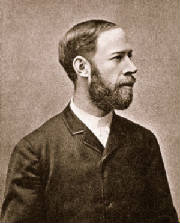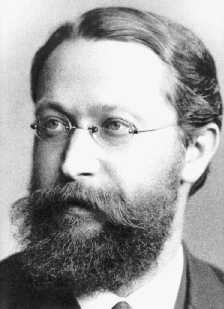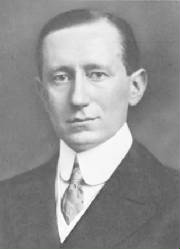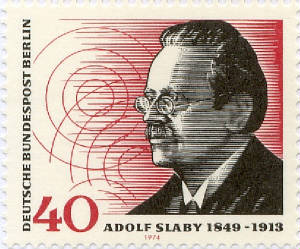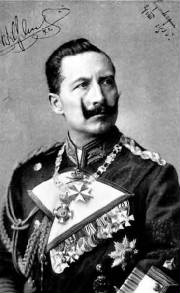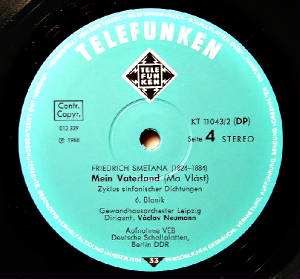The History of Telefunken AG
The Beginning of Radio
James Clerk Maxwell developed his theory of electromagnetism between 1861 and 1865 based on the work of Michael Faraday. As his theory was being discussed, scientists were trying to derive experiments to prove or disprove his theory. One such scientist was Heinrich Rudolf Hertz (the namesake of the measurement of frequency). Hertz worked on a series of experiments based on Maxwell’s theories that in 1887 led to the first successful transmission and reception of radio waves. Once the concept of electromagnetic waves was proven, the scientific community readily recognized and prepared for the day when wireless transmission would be achieved. Throughout the US and Europe, various scientists and inventors put forth ideas, papers and even nebulous patents regarding wireless transmissions, later to be known as radio.
With the advent of a burgeoning scientific field under way, the business climate at this time was different than in previous points in history where rich scientific achievements had been born. Corporations had been around for a long time, but they
largely were held under the thumbs of the various governments of the world. By the mid 1800’s both the US and the UK had dramatically changed their legal stances on the roles of corporations, their liabilities and how they could conduct business. They had more freedom and rights than at any previous time in history. Other countries summarily followed this path as well.
At the same time, patent law was evolving. While patents had been around for centuries, they typically were localized to a specific country. With the increase in travel, communication and shared knowledge, the role of patents in the international community were changing and becoming more powerful. With all of these legal and business changes, people realized that a corporation armed with patents in emerging technologies based on global communication could potentially control global communications and receive fees from the entire world. This realization would make the California gold rush look refined and gentlemanly compared to the Radio rush at the turn of the 20thcentury. This brings us to the events that caused the formation of the corporation Telefunken AG.
Army vs Navy
At the turn of the 20th century there were two separate groups within Germany that were experimenting with vacuum tube technology and its application to wireless broadcasting; the Army, and the Navy. Both branches of the military recognized the strategic value within the applications of broadcasting the news and two way radio communications. Unfortunately, there was a power struggle going on between the two branches. The Army felt that any future wars would be fought on soil. The Navy felt that they were the military force of the future and the Army was outdated. Each saw wireless telegraphy, as it was referred to at that time, as the key to prove that their branch was the more valuable.
Technical University of Berlin in 1886. In 1897, Slaby and his assistant von Arco were invited by Sir William Henry Preece, then head of the English telegraph administration, to participate in wireless transmission experiments with Guglielmo Marconi across the English Channel. On October 7, 1897, Slaby and von Arco established a radio link between Schöneberg and Rangsdorf a distance of 21 kilometers; a new world record in radio transmission at that time. The following summer, Slaby and von Arco established a radio link between Berlin and Jüterbog a distance of over 60 kilometers.
The Army’s research was managed by the company Siemens & Halske with contributions by Karl Ferdinand Braun. Braun received a PHD from the University of Berlin in 1872 and became the Director of the Physical Institute and Professor of Physics at the University of Strasbourg in 1895. In 1897, Braun made his break through with the invention of the cathode ray tube oscilloscope, the technology that was the basis for all TV and computer monitors throughout the entire 20th century. In 1898, Braun invented the crystal diode rectifier which was used on early radio transmitters and held many other patents including a British patent on tuning technology for wireless telegraphy. Marconi used many of Braun’s patents in his own work and in 1909, Braun and Marconi shared the Nobel Peace Prize in Physics for their contributions to wireless telegraphy.
The Navy’s research was managed by the company AEG (Allgemeine Elektrizitäts-Gesellschaft, or General Electricity Company) with the help of Adolf Karl Heinrich Slaby and Georg Wilhlem Alexander Hans Graf von Arco. Slaby had studied under Werner von Siemens and eventually became the first professor of Electro-technology at the
In 1903 these developments and rivalries all came to a head due to two separate incidents. The first incident was that Slaby sent a radiogram (think wireless telegram) to a station in England that was managed by the Marconi Wireless Telegraph Co. Since the originating broadcast location of the radiogram was not an MWT Co. owned station, they refused to accept and deliver the radiogram. This sent shockwaves throughout the German wireless telegraphy industry as they quickly realized that if left unchecked, Marconi’s company would own a monopoly on all wireless broadcasts around the world which would leave their research and efforts at the mercy of the MWT Co’s needs and whims.
At the same time that this realization was sinking in, AEG and Siemens were now actively engaged in ongoing arguments over which company was entitled to which patents regarding advances in wireless telegraphy. Each company wanted to be granted patents in order to keep the other company out of the German wireless telegraphy business. The argument was escalated due to the fact that each company was representing a different branch of the military that wanted to have control of this highly useful technology for each of their purposes. Essentially, the Army and Navy were having a fight a political fight vicariously through two manufacturing companies.
Telefunken is Born
Kaiser Wilhelm II realizing what was at stake, commanded that the two companies, AEG and Siemens, create a joint venture specifically for the purpose of advancing wireless telegraphy together. The company was founded on May 27th, 1903 and called the Gesellschaft für drahtlose Telegrafen mbH (Telefunken), or Telefunken Society for Wireless Telegraph, Ltd. The telegraph address for the company was shortened to just Telefunken. It was to this society to whom the patents for all advancements in wireless telegraphy would be granted and each company would work together to manufacture the components necessary for building a broadcast infrastructure for Germany. Georg Graf von Arco became the first Technical Director of this joint venture. In 1923 the company name was modified to Firmierung in Telefunken, Gesellschaft für drahtlose Telegrafen mbH or Corporate Name in Telefunken, Society for Wireless Telegraph, Ltd. The word Telefunken was created from “Tele” a portion of telegrafen or telegraphy and “funken” meaning sparks. Hence the logo has lightning bolts or “sparks” emanating from the word Telefunken
The creation of this entity and the manner in which it came about paved the way for Telefunken to achieve its market dominance throughout Europe. German universities and the military were providing all of their radio and electronic research to either Siemens or AEG who in turn were placing all of their patents in these areas under the Telefunken corporation. Telefunken received all of the German government contracts to build radio stations in Germany and their colonies while other continental European nations also hired Telefunken to fulfill their radio broadcast needs. By the 1960’s almost every radio station in non-communist Europe was using radio equipment from Telefunken.
Telefunken through the Ages
Over time, Telefunken moved away from predominantly military and governmental projects and into products for the home. In 1923, Telefunken laid the foundation for radio in Germany. In the 1930’s, Telefunken entered the television marketplace, recording, and records manufacturing businesses and started to become a household name in Germany and throughout Europe.
In 1941, Siemens transferred its shares in Telefunken over to AEG. This agreement came to be known as the “Telefunken Settlement” and made AEG the sole owner of Telefunken and any of its remaining patents. AEG continued to run Telefunken as a wholly owned subsidiary eventually changing its business status to Telefunken GmbH (Ltd.) in 1955 and eventually Telefunken AG in 1963. Finally in 1967, Telefunken was merged with AEG and the company name became AEG-Telefunken.
Due to vast mismanagement, AEG-Telefunken started their long slide to oblivion in 1970 that would finally end with the name AEG deleted in 1996.
Starting in 1970, AEG was having profit issues to the point where they sought out third parties to take over portions of their business and outsource entire business segments. In January, 1980, an extraordinary general meeting was held to discuss a capital reduction plan, an inflow of capital plan and a reorganization plan. From 1981-1984 various amounts of capital were injected into the company, businesses and technology were sold off and divisions shut down. After three years of constant analysis, action and reorganization, the company didn’t look any better than it did before all of the procedures. Finally in 1985, Daimler-Benz AG bought what remained of AEG-Telefunken and Telefunken was dropped from the name. In 1996, any mention of the name AEG was dropped from use. Shortly thereafter, the Telefunken name was removed and all activities relating to audio products ceased.
Today, the company name has been renewed as a holding company; Telefunken Holding AG and they are responsible for the name Telefunken and its use worldwide. In the US, the Telefunken name had been abandoned and was eventually reacquired by Telefunken USA to make reproductions of the original Telefunken microphones. They were recently awarded the name Telefunken Elektroakustik by Telefunken Holding AG with the rights to use that name for microphones and audio equipment in 27 different countries. Sadly though, the original company that helped make the Beatles heard around the world and become a household name is no more.
* Photos Courtesy of Wikimedia
Also Read:

